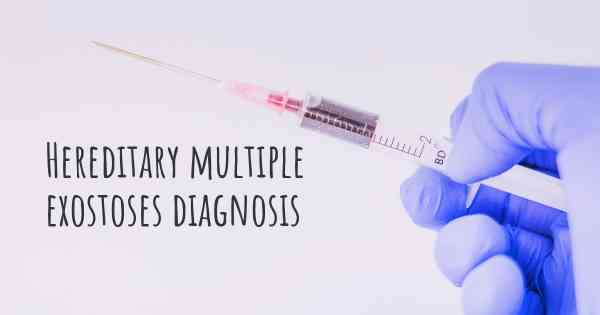How is Hereditary multiple exostoses diagnosed?
See how Hereditary multiple exostoses is diagnosed. Which specialists are essential to meet, what tests are needed and other useful information for the diagnosis of Hereditary multiple exostoses

Diagnosis of Hereditary Multiple Exostoses
Hereditary Multiple Exostoses (HME), also known as Multiple Osteochondromas, is a rare genetic disorder characterized by the development of multiple benign bone tumors called osteochondromas. These tumors typically appear during childhood or adolescence and can affect various bones throughout the body.
Diagnosing HME involves a combination of clinical evaluation, imaging studies, and genetic testing. The process aims to identify the presence of osteochondromas, assess their location and size, and confirm the underlying genetic mutation responsible for the condition.
Clinical Evaluation
The initial step in diagnosing HME involves a thorough clinical evaluation by a healthcare professional, typically an orthopedic specialist or geneticist. The doctor will review the patient's medical history, conduct a physical examination, and inquire about any symptoms or family history of similar conditions.
During the physical examination, the doctor will carefully examine the patient's bones and joints, looking for any visible or palpable bumps or deformities. They may also assess the range of motion, strength, and stability of the affected joints.
Imaging Studies
Imaging studies play a crucial role in the diagnosis of HME. The most commonly used imaging techniques include:
1. X-rays:
X-rays are often the first imaging modality used to evaluate suspected cases of HME. They can reveal the presence of osteochondromas, their number, size, and location. X-rays can also help identify any complications associated with the tumors, such as bone deformities, growth plate abnormalities, or joint problems.
2. Magnetic Resonance Imaging (MRI):
MRI scans provide detailed images of the bones, cartilage, and soft tissues. They are particularly useful in assessing the extent of osteochondromas, especially when they are located near joints or vital structures. MRI can help determine the size, shape, and relationship of the tumors to surrounding tissues, aiding in treatment planning.
3. Computed Tomography (CT) Scan:
CT scans utilize a series of X-ray images taken from different angles to create cross-sectional images of the body. They can provide more detailed information about the size, shape, and internal structure of osteochondromas. CT scans are especially valuable when evaluating complex or deep-seated tumors.
Genetic Testing
Genetic testing is the definitive method to confirm a diagnosis of HME and identify the specific genetic mutation responsible for the condition. This testing is typically performed after clinical evaluation and imaging studies suggest the presence of multiple osteochondromas.
The most common genetic mutation associated with HME is a mutation in the EXT1 or EXT2 gene. Genetic testing involves analyzing a blood or saliva sample to identify mutations in these genes. The presence of a mutation confirms the diagnosis of HME.
Additional Considerations
It is important to note that the diagnosis of HME can be challenging due to its variable presentation and overlap with other conditions. In some cases, a biopsy may be necessary to differentiate osteochondromas from other bone tumors.
Furthermore, genetic testing can also be valuable for family members of individuals diagnosed with HME. Testing can help identify individuals who carry the genetic mutation but may not yet exhibit symptoms. Early identification allows for regular monitoring and appropriate management to prevent complications.
Conclusion
Diagnosing Hereditary Multiple Exostoses involves a comprehensive approach that includes clinical evaluation, imaging studies, and genetic testing. The combination of these methods allows healthcare professionals to identify the presence of osteochondromas, assess their characteristics, and confirm the underlying genetic mutation responsible for the condition. Early diagnosis is crucial for implementing appropriate management strategies and preventing potential complications associated with HME.
Posted Sep 12, 2017 by Helmina Batubara 700
Posted Nov 30, 2017 by Zahra 1950








